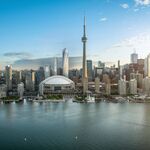DSCToronto
Superstar
Member Bio
- Joined
- Jan 13, 2008
- Messages
- 20,068
- Reaction score
- 29,431
- Location
- St Lawrence Market Area
More info on the new 'patio stuff' at https://www.toronto.ca/city-governm...anning-studies-initiatives/king-street-pilot/
The curb lane public spaces between Bathurst and Jarvis Streets are currently delineated by planters. Local businesses were offered the opportunity to claim the public spaces on the block adjacent to their business for their use. Spaces not claimed by local businesses were included in the Everyone is King design build competition.
"I was really excited to see the calibre of the submissions to the design competition," said Councillor Lucy Troisi (Ward 28 Toronto Centre-Rosedale). "I can't wait to see how they translate from paper to reality over the next few weeks. I hope everyone takes the opportunity to visit King Street and enjoy these installations."
The competition saw a total of 96 entries in two categories. The winning projects from the design build competition are:
Stream 1: temporary public space installations • Asphalt Poetry by Plant Architect Inc. in collaboration with Poet Ronna Bloom • #WouldYouRatherTO by Urban Minds • The Spark by Andrea Bickley, Edvard Bruun, Alex Flash, Alice Huang, Camille Kauffman, Michael Laanvere, Tudor Munteanu, Éamonn Pinto, Rebecca Shaw • The Present Moment by Hello Kirsten • Ziggy by Julia Jamrozik and Coryn Kempster • Woggle Jungle by VPA Studio: Victor Perez-Amado, Anton Skorishchenko, Michael De Luca • Everyone is (a) Kid by Anthony Renditya, Chelsea Alexander, Ian Kendall, Iva Mihaylova, Jeffrey Kwong, Katrina Beaudette, Krysia Bussiere, Ryan Guiricich, Sam Spagnuolo • Watch Your Step! by Stephanie Boutari • The King \ St by BRENS North America in collaboration with O2 Planning + Design • King's Buried Treasure by Karen Roberts in collaboration with Cindy Scaife and Marg Cresswell
Stream 2: durable destination parklets
• Face to Face/Tête à Tête by PLANT Architect Inc.
• King Street Causeway by IBI Group in collaboration with PCL Construction
The curb lane public spaces between Bathurst and Jarvis Streets are currently delineated by planters. Local businesses were offered the opportunity to claim the public spaces on the block adjacent to their business for their use. Spaces not claimed by local businesses were included in the Everyone is King design build competition.
"I was really excited to see the calibre of the submissions to the design competition," said Councillor Lucy Troisi (Ward 28 Toronto Centre-Rosedale). "I can't wait to see how they translate from paper to reality over the next few weeks. I hope everyone takes the opportunity to visit King Street and enjoy these installations."
The competition saw a total of 96 entries in two categories. The winning projects from the design build competition are:
Stream 1: temporary public space installations • Asphalt Poetry by Plant Architect Inc. in collaboration with Poet Ronna Bloom • #WouldYouRatherTO by Urban Minds • The Spark by Andrea Bickley, Edvard Bruun, Alex Flash, Alice Huang, Camille Kauffman, Michael Laanvere, Tudor Munteanu, Éamonn Pinto, Rebecca Shaw • The Present Moment by Hello Kirsten • Ziggy by Julia Jamrozik and Coryn Kempster • Woggle Jungle by VPA Studio: Victor Perez-Amado, Anton Skorishchenko, Michael De Luca • Everyone is (a) Kid by Anthony Renditya, Chelsea Alexander, Ian Kendall, Iva Mihaylova, Jeffrey Kwong, Katrina Beaudette, Krysia Bussiere, Ryan Guiricich, Sam Spagnuolo • Watch Your Step! by Stephanie Boutari • The King \ St by BRENS North America in collaboration with O2 Planning + Design • King's Buried Treasure by Karen Roberts in collaboration with Cindy Scaife and Marg Cresswell
Stream 2: durable destination parklets
• Face to Face/Tête à Tête by PLANT Architect Inc.
• King Street Causeway by IBI Group in collaboration with PCL Construction






